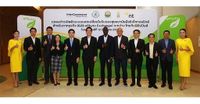Thailand continues to solidify its position as a global powerhouse in agricultural exports, with the Ministry of Commerce revealing impressive figures for 2024 that underscore the country’s dominance in several key product categories. According to Mr. Poonpong Naiyanapakorn, Director-General of the Trade Policy and Strategy Office (TPSO) and spokesperson for the Ministry of Commerce, the total export value of Thai agricultural and agro-industrial products reached an astounding 52.185 billion USD (approximately 1.8358 trillion baht), marking a 5.9% increase over the previous year.
This growth was driven by a 7.5% rise in agricultural product exports, which totaled 28.827 billion USD, alongside a 4.1% increase in agro-industrial goods, which accounted for 23.358 billion USD. These figures not only highlight Thailand’s robust agricultural sector but also its ability to compete and lead in the global marketplace.
Among the standout performers, tapioca starch (HS Code 110814) emerged as a champion, with exports valued at 1.612 billion USD—an 8.86% increase that secured Thailand a commanding 57% share of the global tapioca starch market, which itself saw a slight decline of 2.59% worldwide. This dominance illustrates Thailand’s exceptional production capabilities and market penetration in this staple commodity.
Durian, often called the “king of fruits,” remains a vital export product, accounting for 3.818 billion USD in exports, though this represented a 5.87% decrease. Still, Thailand holds a 54.2% share of the global durian export market, which overall grew by 7.27%. This divergence signals a need for Thailand to adapt and innovate to maintain its leading position as competitors gain ground.
Similarly, fresh and dried coconuts (HS Code 080119) saw exports drop by 23.68% to 226.2 million USD, with Thailand’s market share slipping to 37.2% amid a global export increase of 12.19%. This downward trend in key products like coconuts and durians highlights the urgency for Thai producers to enhance product quality and competitiveness to fend off rising challengers.
In contrast, natural rubber (HS Code 4001) demonstrated remarkable growth, with exports soaring by 37.26% to nearly 5 billion USD, securing a 31.3% share of the global market. This outpaced the global rubber export growth of 26.13%, underscoring Thailand’s strength in this sector.
Other products such as canned pineapple (HS Code 200820), processed chicken (HS Code 160232), and canned tuna (HS Code 160414) also recorded healthy export growths of 7.14%, 8.12%, and 20.15% respectively. Thailand maintains substantial shares in these markets—30.8%, 25.6%, and 25.5%—further cementing its reputation as a leading food exporter.
However, not all categories fared as well. Certain products that previously held the top spot in global exports have begun to lose their dominance. For instance, whole coconuts (HS Code 080112) dropped to the second position globally, with exports falling nearly 39% to 92.2 million USD. Indonesia overtook Thailand with a 33.4% market share compared to Thailand’s 27.1%. Similarly, cassava roots and pellets (HS Code 071410) and cassava flour (HS Code 110620) also slipped to second place, with Cambodia and Peru taking the lead respectively. These shifts serve as a stark reminder of the competitive pressures Thailand faces and the necessity for strategic improvements.
In response to these challenges, the Thai government is actively promoting initiatives to support farmers and exporters. One such effort involves the distribution of premium-grade Thai fruits to various provinces, including northern mangoes and eastern durians, mangosteen, and rambutan, to stimulate domestic consumption and open new sales channels, particularly in the northeastern region. This move aims to balance export demands with local market growth, helping farmers achieve better incomes.
Moreover, the government’s One Tambon One Product (OTOP) initiative continues to empower communities by providing modern knowledge, financial resources, and marketing skills to enhance product quality and market access. The recent OTOP Midyear 2025 event, inaugurated by the Prime Minister, is expected to generate over 600 million baht in economic activity, reflecting the program’s success in fostering local entrepreneurship and linking rural products to broader markets.
Complementing these efforts, a significant technological advancement was unveiled on June 12, 2025, when NT, a leading Thai telecommunications and digital service provider, officially launched the B2B ePhyto Exchange system. This innovative platform digitizes the issuance and exchange of electronic phytosanitary certificates (ePhyto), which are crucial for the export of plants and plant products. The system was launched in collaboration with InterCommerce from the Philippines and supported by multiple government agencies including the Department of Agriculture, Customs Department, and the Thai Industrial Standards Institute (TISI).
Dr. Wongkot Vijakkhana, NT’s Senior Executive Vice President for Digital Business and Solutions, emphasized that this collaboration marks a milestone in streamlining Thailand’s export processes, reducing time and costs, and enhancing transparency and security for exporters. Mr. Francis Lopez, President of InterCommerce and Deputy Chair of the PAA Digital Trade Alliance, highlighted that the initiative facilitates cross-border trade by enabling seamless B2B exchange of ePhyto documents between Thailand and the Philippines, with plans to extend connectivity to other countries.
Government officials echoed the system’s importance. The Department of Agriculture noted that the ePhyto system ensures faster, safer, and internationally compliant data exchange between public and private sectors. The Customs Department underscored its commitment to modernizing the National Single Window (NSW) platform to maintain global standards and aims to integrate ePhyto exchanges with major trade partners like China within the next couple of years. Meanwhile, TISI continues to coordinate international negotiations to open markets and resolve trade barriers.
All these developments reflect Thailand’s comprehensive approach to maintaining and enhancing its status as a global agricultural leader. While the country celebrates its export achievements, it is also keenly aware of the challenges ahead, especially in sectors where competitors are gaining ground. The combined efforts of government support programs, technological innovation, and strategic market expansion are designed to ensure that Thailand not only preserves its crown as the “world’s kitchen” but also adapts dynamically to the evolving global trade landscape.
As the world watches, Thailand’s agricultural sector stands at a pivotal crossroads—balancing tradition with innovation, local livelihoods with global markets, and current successes with future resilience.




